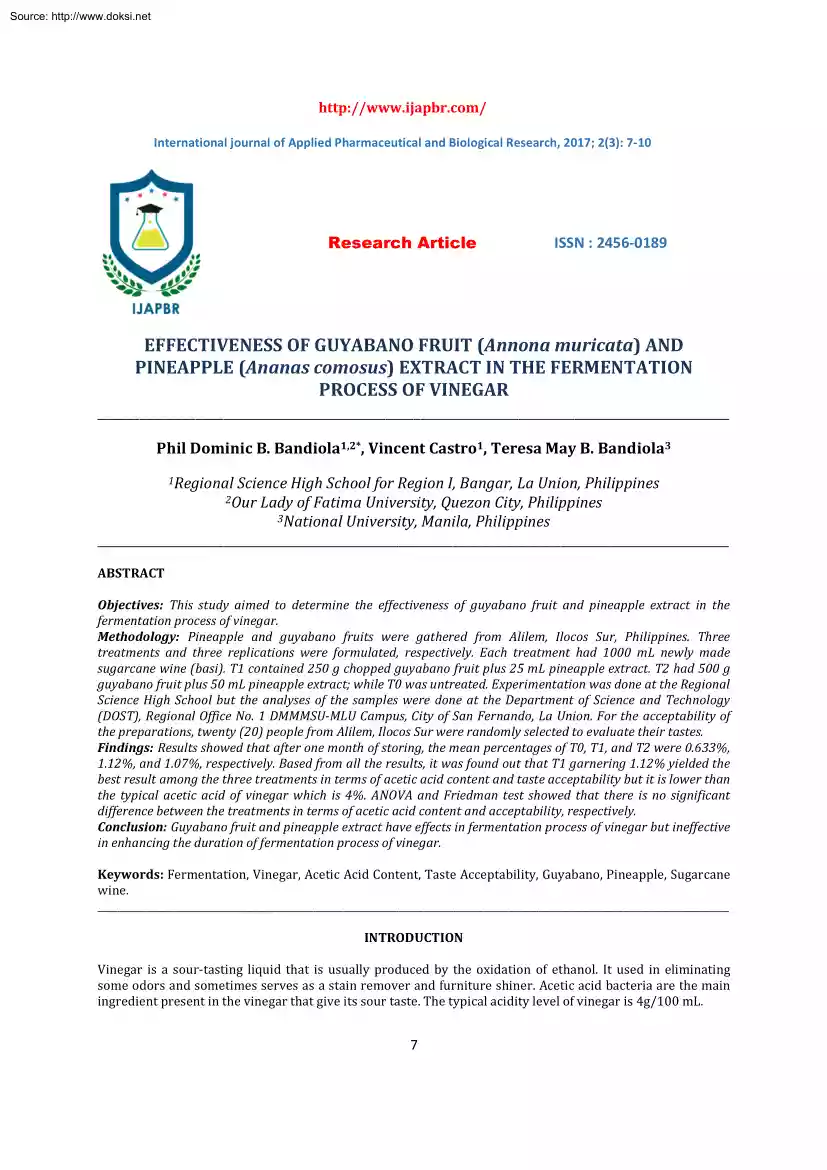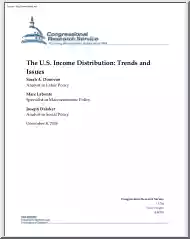Please log in to read this in our online viewer!

Please log in to read this in our online viewer!
No comments yet. You can be the first!
What did others read after this?
Content extract
Source: http://www.doksinet http://www.ijapbrcom/ International journal of Applied Pharmaceutical and Biological Research, 2017; 2(3): 7-10 Research Article ISSN : 2456-0189 EFFECTIVENESS OF GUYABANO FRUIT (Annona muricata) AND PINEAPPLE (Ananas comosus) EXTRACT IN THE FERMENTATION PROCESS OF VINEGAR Phil Dominic B. Bandiola1,2*, Vincent Castro1, Teresa May B. Bandiola3 1Regional Science High School for Region I, Bangar, La Union, Philippines 2Our Lady of Fatima University, Quezon City, Philippines 3National University, Manila, Philippines ABSTRACT Objectives: This study aimed to determine the effectiveness of guyabano fruit and pineapple extract in the fermentation process of vinegar. Methodology: Pineapple and guyabano fruits were gathered from Alilem, Ilocos Sur, Philippines. Three
treatments and three replications were formulated, respectively. Each treatment had 1000 mL newly made sugarcane wine (basi). T1 contained 250 g chopped guyabano fruit plus 25 mL pineapple extract T2 had 500 g guyabano fruit plus 50 mL pineapple extract; while T0 was untreated. Experimentation was done at the Regional Science High School but the analyses of the samples were done at the Department of Science and Technology (DOST), Regional Office No. 1 DMMMSU-MLU Campus, City of San Fernando, La Union For the acceptability of the preparations, twenty (20) people from Alilem, Ilocos Sur were randomly selected to evaluate their tastes. Findings: Results showed that after one month of storing, the mean percentages of T0, T1, and T2 were 0.633%, 1.12%, and 107%, respectively Based from all the results, it was found out that T1 garnering 112% yielded the best result among the three treatments in terms of acetic acid content and taste acceptability but it is lower than the typical acetic acid
of vinegar which is 4%. ANOVA and Friedman test showed that there is no significant difference between the treatments in terms of acetic acid content and acceptability, respectively. Conclusion: Guyabano fruit and pineapple extract have effects in fermentation process of vinegar but ineffective in enhancing the duration of fermentation process of vinegar. Keywords: Fermentation, Vinegar, Acetic Acid Content, Taste Acceptability, Guyabano, Pineapple, Sugarcane wine. INTRODUCTION Vinegar is a sour-tasting liquid that is usually produced by the oxidation of ethanol. It used in eliminating some odors and sometimes serves as a stain remover and furniture shiner. Acetic acid bacteria are the main ingredient present in the vinegar that give its sour taste. The typical acidity level of vinegar is 4g/100 mL 7 Source: http://www.doksinet Available Online :
www.ijapbrcom Phil D. B Bandiola et al IJAPBR, 2017; 2(3): 7-10 In the field of agriculture, the Philippines ranks as one of the best vinegar producers in Asia. Vinegar production is one the livelihoods of the farmers, wherein vinegars are made out of sugarcane wine. Fermentation of vinegar is quite long, and it takes many months to ferment a sugarcane wine. Because of this struggle, the production of vinegar takes a long time to produce vinegar. Thus, the fermentation process is the most sought problems in vinegar making. In the old process of fermentation, ancestral Filipino farmers and vinegar makers used yeast to enhance the rapid fermentation of the sugarcane wine. There is need then to look for alternative solution to solve this problem. One way to solve it is to look for plants that are capable of enhancing the fermentation process of vinegar; plants which are high in ethanol. Based on studies, the plants that are high in ethanol are guyabano and pineapple. This ethanol, when
reacts with oxygen, will produce vinegar: C2H5OH + O2 CH3COOH + H2O. This component of guyabano specifically the fruit and pineapple extract led the researchers to venture on a study entitled, “Effectiveness of Guyabano fruit (Annonamuricata) and Pineapple (Ananascomosus) Extract in the Fermentation Process of Vinegar.” MATERIALS AND METHODS Materials Used Guyabano fruit and pineapple extract were used as primary materials which were gathered from Alilem, Ilocos Sur, Philippines. A newly made sugarcane wine was bought at the same location and vinegar containers were used to contain the treatments for the time of storing. Moreover, weighing scale was used to measure the amount of fruit needed for the treatments, beaker to measure the amount of sugarcane wine, measuring cup to measure the amount of the pineapple extract, knife to chop the fruits into pieces and lastly, cheesecloth to get the extract from pineapple. Preparation of Treatments T0 is prepared securing 1000 mL newly
made pure sugarcane wine. Likewise, T1 is prepared by mixing 250 g guyabano fruit, 25 mL pineapple extract, and 1000 mL sugarcane wine. T2 was also prepared by mixing 500 g guyabano fruit, 50 mL pineapple extract, and 1000mL sugarcane wine. Fermentation of Treatments The three treatments (T0, T1, and T2) were placed at the storage room at the researcher’s residence. They were stored for one month (July-August, 2014). Gathering of Data Acetic Acid Content After one month of storing (July-August, 2014) , the samples were brought to the Department of Science and Technology (DOST) to determine their acetic acid content using titrimetry as the volumetric process. Titration was performed by slowly adding the titrant to the analyte solution via buret until an endpoint is reached. The endpoint is represented by some distinct physical change in analyte solution; typically an indicator color change. The analyte is then the acetic acid bacteria in the vinegar and the titrant as a dilute
solution of a strong base, sodium hydroxide (NaOH). Acceptability Using a questionnaire survey form, the taste of the different treatments was evaluated at random by twenty people as panellists. The treatments were rated according to their sourness Very satisfactory (3) means very sour or having a sharp acid taste; satisfactory (2) if the vinegar has slightly sharp acid taste; and less satisfactory (1) if the vinegar is not sour and having a less sharp acid taste. Fermentation Rate The acetic acid content of the vinegar was determined through the titration method by the Department of Science and Technology (DOST). It was done by titrating the acetic acid present with a string base, sodium 8 Source: http://www.doksinet Available Online : www.ijapbrcom Phil D. B Bandiola et al IJAPBR, 2017; 2(3): 7-10 hydroxide (NaOH). Statistical Tool ANOVA and Friedman test were applied for the statistical treatment of results. RESULTS The results are tabulated in Table1 and Table 2. Table
1.Acetic Acid Content Trial 1 2 3 Total Mean T0 0.62% 0.65% 0.63% 1.9% 0.633% T1 1.34% 0.68% 1.34% 3.36% 1.12% T2 1.34% 1.19% 0.73% 3.26% 1.07% Table 1 shows the acetic acid content of the treatments after one month. T0 or the control (untreated) which is soon to be fermented sugarcane wine has a percentage mean of 0.633%, while T1, the treatment treated with 25 g of guyabano fruit and 25 mL of pineapple extract has a percentage mean of 1.12%, and T2, the treatment treated with 500 g of guyabano and 50 mL of pineapple extract has a percentage mean of 1.07% According to the Department of Science and Technology (DOST), a good quality of vinegar must reach at least 4% of its acetic acid content. The results indicate that the vinegar in the treatments has not yet fermented The time allotted which is one month for each treatment was not enough that caused the acetic acid content low. Based from the conducted ANOVA (Analysis of Variance), there is no significant difference among the
treatments in terms of acetic acid content. Fcrit is greater than Fcal Thus, T1 or the sugarcane wine with 250 g of guyabano fruit and 25 mL of pineapple extract yields the best result among the treatments in terms of acetic acid content since its percentage mean is 1.12% Since the percentage mean of the treated samples are below 4%, therefore it is not a good quality of vinegar. This proves that the guyabano fruit and pineapple extract are ineffective in enhancing the fermentation process of the vinegar. Table 2.Acceptability Test on Taste Panelist No. 1 2 3 4 5 6 7 8 9 10 11 12 13 14 15 16 17 18 19 20 Total Mean T0 2 2 3 3 2 2 2 1 3 3 2 2 3 3 3 3 3 2 2 3 49 2.45 T1 3 3 2 2 3 3 3 3 2 2 3 3 2 2 2 2 2 3 3 2 50 2.50 T2 1 1 1 1 1 1 1 2 1 1 1 1 1 1 1 1 1 1 1 1 21 1.05 Rank 0 2 2 3 3 2 2 2 1 3 3 2 2 3 3 3 3 3 2 2 3 49 R1=2.45 Rank 1 3 3 2 2 3 3 3 3 2 2 3 3 2 2 2 2 2 3 3 2 50 R2=2.50 Rank 2 1 1 1 1 1 1 1 2 1 1 1 1 1 1 1 1 1 1 1 1 21 R3=1.05 Table 2 shows the results of the
acceptability test of the treatments in terms of taste. These were evaluated by twenty randomly selected people with a response rate of 100%. Taste acceptability was assessed using the 9 Source: http://www.doksinet Available Online : www.ijapbrcom Phil D. B Bandiola et al IJAPBR, 2017; 2(3): 7-10 following criteria: Very satisfactory (3) means very sour or having a sharp acid taste; satisfactory (2) if the vinegar has slightly sharp acid taste; and less satisfactory (1) if the vinegar is not sour and having a less sharp acid taste. It shows that T2 was less satisfactory and still didn’t have an acidic taste; and T1 with 1000 mL sugarcane with 250 g of guyabano fruit and 25 mL of pineapple extract had the strongest sour taste. Based from the conducted Friedman Test, x2 is greater than Fr. It means there is no significant difference among the treatments in terms of acceptability. DISCUSSION The study provides useful information about the effects of guyabano fruit and pineapple
extract in the fermentation process of vinegar. Although it was found out that T1 garnering 112% yielded the best result among the three treatments in terms of acetic acid content and taste acceptability, it is still lower than the typical acetic acid of vinegar which is 4%. This is because the time allotted which is one month for each treatment was not enough that caused the acetic acid content to be low. Hence, the study showed that they are ineffective in enhancing the fermentation process of vinegar. CONCLUSION Guyabano fruit and pineapple extract have the effects in the fermentation process of vinegar but ineffective in enhancing the said process. T1, with 112% yield, had proven to have the best result among the three treatments in terms of acetic acid content and taste acceptability but it is lower than the typical acetic acid of vinegar which is 4%. This proves that the component of guyabano fruit and pineapple extract particularly ethanol made the production of acetic acid
lesser. ANOVA and Friedman test showed that there is no significant difference between the treatments in terms of acetic acid content and acceptability, respectively. Acknowledgement The researchers would like to thank the residents of Alilem, Ilocos Sur, Philippines who whole-heartedly devoted their time to the study and the research advisers and members of the tribunal of Regional Science High School for Region I. Above all, to the Almighty Father for bestowing the researchers enthusiasm and wisdom throughout the study. REFERENCES 1) glunberg@medscape.com (Site visited on 1222017 ) 2) http://medicalhealthguide.com/herb/guyabanohtm (Site visited on 18 22017 ) 3) www.newworldencyclopediaorg/entry/vinegar (Site visited on 2422017 ) 4) http://pelagiaresearchlibrary.com/advances-in-applied-science/vol5-iss1/AASR-2014-5-1-106-110pdf 10
treatments and three replications were formulated, respectively. Each treatment had 1000 mL newly made sugarcane wine (basi). T1 contained 250 g chopped guyabano fruit plus 25 mL pineapple extract T2 had 500 g guyabano fruit plus 50 mL pineapple extract; while T0 was untreated. Experimentation was done at the Regional Science High School but the analyses of the samples were done at the Department of Science and Technology (DOST), Regional Office No. 1 DMMMSU-MLU Campus, City of San Fernando, La Union For the acceptability of the preparations, twenty (20) people from Alilem, Ilocos Sur were randomly selected to evaluate their tastes. Findings: Results showed that after one month of storing, the mean percentages of T0, T1, and T2 were 0.633%, 1.12%, and 107%, respectively Based from all the results, it was found out that T1 garnering 112% yielded the best result among the three treatments in terms of acetic acid content and taste acceptability but it is lower than the typical acetic acid
of vinegar which is 4%. ANOVA and Friedman test showed that there is no significant difference between the treatments in terms of acetic acid content and acceptability, respectively. Conclusion: Guyabano fruit and pineapple extract have effects in fermentation process of vinegar but ineffective in enhancing the duration of fermentation process of vinegar. Keywords: Fermentation, Vinegar, Acetic Acid Content, Taste Acceptability, Guyabano, Pineapple, Sugarcane wine. INTRODUCTION Vinegar is a sour-tasting liquid that is usually produced by the oxidation of ethanol. It used in eliminating some odors and sometimes serves as a stain remover and furniture shiner. Acetic acid bacteria are the main ingredient present in the vinegar that give its sour taste. The typical acidity level of vinegar is 4g/100 mL 7 Source: http://www.doksinet Available Online :
www.ijapbrcom Phil D. B Bandiola et al IJAPBR, 2017; 2(3): 7-10 In the field of agriculture, the Philippines ranks as one of the best vinegar producers in Asia. Vinegar production is one the livelihoods of the farmers, wherein vinegars are made out of sugarcane wine. Fermentation of vinegar is quite long, and it takes many months to ferment a sugarcane wine. Because of this struggle, the production of vinegar takes a long time to produce vinegar. Thus, the fermentation process is the most sought problems in vinegar making. In the old process of fermentation, ancestral Filipino farmers and vinegar makers used yeast to enhance the rapid fermentation of the sugarcane wine. There is need then to look for alternative solution to solve this problem. One way to solve it is to look for plants that are capable of enhancing the fermentation process of vinegar; plants which are high in ethanol. Based on studies, the plants that are high in ethanol are guyabano and pineapple. This ethanol, when
reacts with oxygen, will produce vinegar: C2H5OH + O2 CH3COOH + H2O. This component of guyabano specifically the fruit and pineapple extract led the researchers to venture on a study entitled, “Effectiveness of Guyabano fruit (Annonamuricata) and Pineapple (Ananascomosus) Extract in the Fermentation Process of Vinegar.” MATERIALS AND METHODS Materials Used Guyabano fruit and pineapple extract were used as primary materials which were gathered from Alilem, Ilocos Sur, Philippines. A newly made sugarcane wine was bought at the same location and vinegar containers were used to contain the treatments for the time of storing. Moreover, weighing scale was used to measure the amount of fruit needed for the treatments, beaker to measure the amount of sugarcane wine, measuring cup to measure the amount of the pineapple extract, knife to chop the fruits into pieces and lastly, cheesecloth to get the extract from pineapple. Preparation of Treatments T0 is prepared securing 1000 mL newly
made pure sugarcane wine. Likewise, T1 is prepared by mixing 250 g guyabano fruit, 25 mL pineapple extract, and 1000 mL sugarcane wine. T2 was also prepared by mixing 500 g guyabano fruit, 50 mL pineapple extract, and 1000mL sugarcane wine. Fermentation of Treatments The three treatments (T0, T1, and T2) were placed at the storage room at the researcher’s residence. They were stored for one month (July-August, 2014). Gathering of Data Acetic Acid Content After one month of storing (July-August, 2014) , the samples were brought to the Department of Science and Technology (DOST) to determine their acetic acid content using titrimetry as the volumetric process. Titration was performed by slowly adding the titrant to the analyte solution via buret until an endpoint is reached. The endpoint is represented by some distinct physical change in analyte solution; typically an indicator color change. The analyte is then the acetic acid bacteria in the vinegar and the titrant as a dilute
solution of a strong base, sodium hydroxide (NaOH). Acceptability Using a questionnaire survey form, the taste of the different treatments was evaluated at random by twenty people as panellists. The treatments were rated according to their sourness Very satisfactory (3) means very sour or having a sharp acid taste; satisfactory (2) if the vinegar has slightly sharp acid taste; and less satisfactory (1) if the vinegar is not sour and having a less sharp acid taste. Fermentation Rate The acetic acid content of the vinegar was determined through the titration method by the Department of Science and Technology (DOST). It was done by titrating the acetic acid present with a string base, sodium 8 Source: http://www.doksinet Available Online : www.ijapbrcom Phil D. B Bandiola et al IJAPBR, 2017; 2(3): 7-10 hydroxide (NaOH). Statistical Tool ANOVA and Friedman test were applied for the statistical treatment of results. RESULTS The results are tabulated in Table1 and Table 2. Table
1.Acetic Acid Content Trial 1 2 3 Total Mean T0 0.62% 0.65% 0.63% 1.9% 0.633% T1 1.34% 0.68% 1.34% 3.36% 1.12% T2 1.34% 1.19% 0.73% 3.26% 1.07% Table 1 shows the acetic acid content of the treatments after one month. T0 or the control (untreated) which is soon to be fermented sugarcane wine has a percentage mean of 0.633%, while T1, the treatment treated with 25 g of guyabano fruit and 25 mL of pineapple extract has a percentage mean of 1.12%, and T2, the treatment treated with 500 g of guyabano and 50 mL of pineapple extract has a percentage mean of 1.07% According to the Department of Science and Technology (DOST), a good quality of vinegar must reach at least 4% of its acetic acid content. The results indicate that the vinegar in the treatments has not yet fermented The time allotted which is one month for each treatment was not enough that caused the acetic acid content low. Based from the conducted ANOVA (Analysis of Variance), there is no significant difference among the
treatments in terms of acetic acid content. Fcrit is greater than Fcal Thus, T1 or the sugarcane wine with 250 g of guyabano fruit and 25 mL of pineapple extract yields the best result among the treatments in terms of acetic acid content since its percentage mean is 1.12% Since the percentage mean of the treated samples are below 4%, therefore it is not a good quality of vinegar. This proves that the guyabano fruit and pineapple extract are ineffective in enhancing the fermentation process of the vinegar. Table 2.Acceptability Test on Taste Panelist No. 1 2 3 4 5 6 7 8 9 10 11 12 13 14 15 16 17 18 19 20 Total Mean T0 2 2 3 3 2 2 2 1 3 3 2 2 3 3 3 3 3 2 2 3 49 2.45 T1 3 3 2 2 3 3 3 3 2 2 3 3 2 2 2 2 2 3 3 2 50 2.50 T2 1 1 1 1 1 1 1 2 1 1 1 1 1 1 1 1 1 1 1 1 21 1.05 Rank 0 2 2 3 3 2 2 2 1 3 3 2 2 3 3 3 3 3 2 2 3 49 R1=2.45 Rank 1 3 3 2 2 3 3 3 3 2 2 3 3 2 2 2 2 2 3 3 2 50 R2=2.50 Rank 2 1 1 1 1 1 1 1 2 1 1 1 1 1 1 1 1 1 1 1 1 21 R3=1.05 Table 2 shows the results of the
acceptability test of the treatments in terms of taste. These were evaluated by twenty randomly selected people with a response rate of 100%. Taste acceptability was assessed using the 9 Source: http://www.doksinet Available Online : www.ijapbrcom Phil D. B Bandiola et al IJAPBR, 2017; 2(3): 7-10 following criteria: Very satisfactory (3) means very sour or having a sharp acid taste; satisfactory (2) if the vinegar has slightly sharp acid taste; and less satisfactory (1) if the vinegar is not sour and having a less sharp acid taste. It shows that T2 was less satisfactory and still didn’t have an acidic taste; and T1 with 1000 mL sugarcane with 250 g of guyabano fruit and 25 mL of pineapple extract had the strongest sour taste. Based from the conducted Friedman Test, x2 is greater than Fr. It means there is no significant difference among the treatments in terms of acceptability. DISCUSSION The study provides useful information about the effects of guyabano fruit and pineapple
extract in the fermentation process of vinegar. Although it was found out that T1 garnering 112% yielded the best result among the three treatments in terms of acetic acid content and taste acceptability, it is still lower than the typical acetic acid of vinegar which is 4%. This is because the time allotted which is one month for each treatment was not enough that caused the acetic acid content to be low. Hence, the study showed that they are ineffective in enhancing the fermentation process of vinegar. CONCLUSION Guyabano fruit and pineapple extract have the effects in the fermentation process of vinegar but ineffective in enhancing the said process. T1, with 112% yield, had proven to have the best result among the three treatments in terms of acetic acid content and taste acceptability but it is lower than the typical acetic acid of vinegar which is 4%. This proves that the component of guyabano fruit and pineapple extract particularly ethanol made the production of acetic acid
lesser. ANOVA and Friedman test showed that there is no significant difference between the treatments in terms of acetic acid content and acceptability, respectively. Acknowledgement The researchers would like to thank the residents of Alilem, Ilocos Sur, Philippines who whole-heartedly devoted their time to the study and the research advisers and members of the tribunal of Regional Science High School for Region I. Above all, to the Almighty Father for bestowing the researchers enthusiasm and wisdom throughout the study. REFERENCES 1) glunberg@medscape.com (Site visited on 1222017 ) 2) http://medicalhealthguide.com/herb/guyabanohtm (Site visited on 18 22017 ) 3) www.newworldencyclopediaorg/entry/vinegar (Site visited on 2422017 ) 4) http://pelagiaresearchlibrary.com/advances-in-applied-science/vol5-iss1/AASR-2014-5-1-106-110pdf 10




 Just like you draw up a plan when you’re going to war, building a house, or even going on vacation, you need to draw up a plan for your business. This tutorial will help you to clearly see where you are and make it possible to understand where you’re going.
Just like you draw up a plan when you’re going to war, building a house, or even going on vacation, you need to draw up a plan for your business. This tutorial will help you to clearly see where you are and make it possible to understand where you’re going.